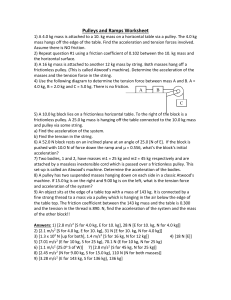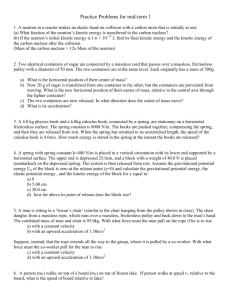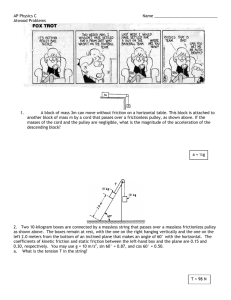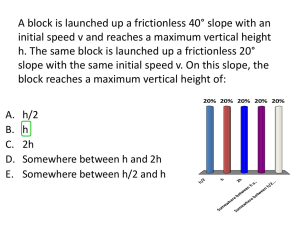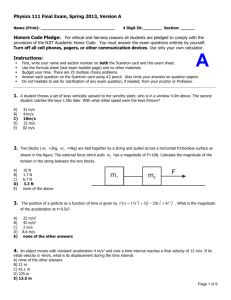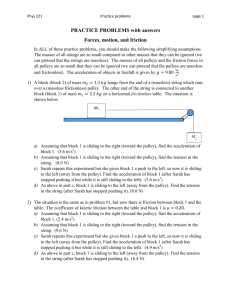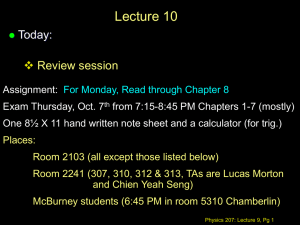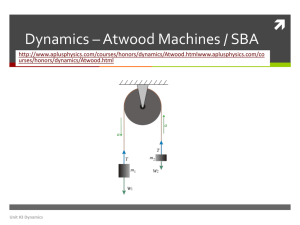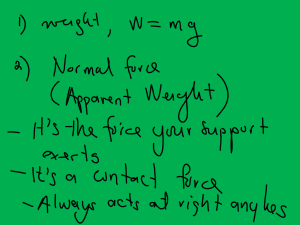File
advertisement
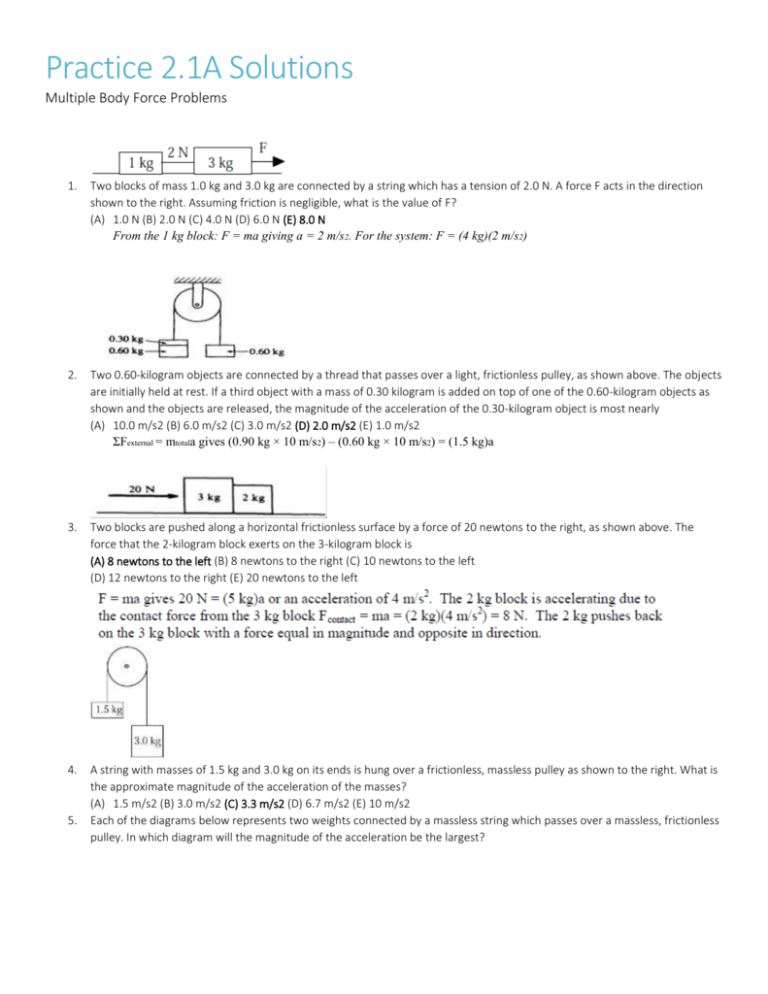
Practice 2.1A Solutions Multiple Body Force Problems 1. Two blocks of mass 1.0 kg and 3.0 kg are connected by a string which has a tension of 2.0 N. A force F acts in the direction shown to the right. Assuming friction is negligible, what is the value of F? (A) 1.0 N (B) 2.0 N (C) 4.0 N (D) 6.0 N (E) 8.0 N From the 1 kg block: F = ma giving a = 2 m/s2. For the system: F = (4 kg)(2 m/s2) 2. Two 0.60-kilogram objects are connected by a thread that passes over a light, frictionless pulley, as shown above. The objects are initially held at rest. If a third object with a mass of 0.30 kilogram is added on top of one of the 0.60-kilogram objects as shown and the objects are released, the magnitude of the acceleration of the 0.30-kilogram object is most nearly (A) 10.0 m/s2 (B) 6.0 m/s2 (C) 3.0 m/s2 (D) 2.0 m/s2 (E) 1.0 m/s2 ΣFexternal = mtotala gives (0.90 kg × 10 m/s2) – (0.60 kg × 10 m/s2) = (1.5 kg)a 3. Two blocks are pushed along a horizontal frictionless surface by a force of 20 newtons to the right, as shown above. The force that the 2-kilogram block exerts on the 3-kilogram block is (A) 8 newtons to the left (B) 8 newtons to the right (C) 10 newtons to the left (D) 12 newtons to the right (E) 20 newtons to the left 4. A string with masses of 1.5 kg and 3.0 kg on its ends is hung over a frictionless, massless pulley as shown to the right. What is the approximate magnitude of the acceleration of the masses? (A) 1.5 m/s2 (B) 3.0 m/s2 (C) 3.3 m/s2 (D) 6.7 m/s2 (E) 10 m/s2 Each of the diagrams below represents two weights connected by a massless string which passes over a massless, frictionless pulley. In which diagram will the magnitude of the acceleration be the largest? 5. Answer: A Free Response Problem 1 A 2–kg block and a 5–kg block are connected as shown above. The coefficient of friction between the 5–kg block and the flat surface is μ = 0.2. a. Calculate the magnitude of the acceleration of the 5–kg block. b. Calculate the tension in the rope connecting the two blocks. Solution Because this block is in equilibrium vertically, the normal force is equal to the block's weight, 50 N. The friction force is μFN, or 10 N. Calling the down–and–right direction positive, we can write two equations, one for each block: (2 kg)g – T = (2 kg)a. T – Ff = (5 kg)a. a. To solve for acceleration, just add the two equations together. The tensions cancel. We find the acceleration to be 1.4 m/s2. b. Plug back into either equation to find the final answer, that the tension is 17 N. This is more than the 14 N we found for the frictionless situation, and so makes sense. We expect that it will take more force in the rope to overcome friction on the table. Problem 2 Two masses, m1 and m2, are hanging by a massless string from a frictionless pulley. If m 1 is greater than m2, determine the acceleration of the two masses when released from rest. Solution Answer: First, identify a direction as positive. Since you can easily observe that m 1 will accelerate downward and m 2 will accelerate upward, since m1 > m2, call the direction of motion around the pulley and down toward m1 the positive y direction. Then, you can create free body diagrams for both object m 1 and m2, as shown below: Using this diagram, write Newton’s 2nd Law equations for both objects, taking care to note the positive y direction: Next, combine the equations and eliminate T by solving for T in equation (2) and substituting in for T in equation (1). Finally, solve for the acceleration of the system. Alternately, you could treat both masses as part of the same system. Drawing a dashed line around the system, you can directly write an appropriate Newton’s 2nd Law equation for the entire system. Note that if the string and pulley were not massless, this problem would become considerably more involved.

